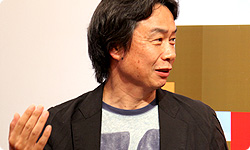4. Write the Problem on a Label
Returning to what you said about being shocked when Yokoi-san called you negative, did you change afterwards?
No, circumstances were a little different then. We weren’t members of the same team. It was a conversation we had while working separately, but toward the same goal.
Oh, I see.
His words did shock me, though. At the time, I don’t think I was the type to aggressively head for a solution the way I do now. If I had been on a team of which Yokoi-san was the leader, it would have not been very easy for me.
Yeah.
But by nature I’m the type to assemble reasons against something rather than reasons in favour of it. As I thought about what Yokoi-san said, I gradually came to understand myself better.
Oh, to view it as your nature, rather than a shortcoming?
That’s the way I think about things. If I do this, it’ll turn out like this, but if I do that, it’ll turn out like that. I imagine all the worst case scenarios.
But isn’t that necessary in a leader?
Yes. So as I get older and the responsibility I bear for getting things done grows heavier, I’ve become able to make subtle decisions when I decide to get things done about whether certain problems I see are fatal or only possess a certain amount of risk.
You’re able to assign a ranking to the size and influence of various drawbacks. That’s important, isn’t it?
Yes. If you can do that, you’ll be able to make solid decisions. So when a younger person asks what’s wrong with their idea, I think, “You really should think about that for yourself.”
Hmm, I see.
If you think for yourself about what’s wrong with your idea, and you understand the reasons why it’s no good and get a handle on the problem, then you’re sure to be able to use that idea sometime.
That’s right. It’s a waste if you just say, “Oh, that idea’s no good,” and forget about it.
That doesn’t lead to anything. That’s why, while I used to tell people to store up ideas in a drawer, I recently suggest putting ideas that were no good into a drawer with the reason why they were no good affixed to them. Like writing the reason on a label.

A drawer of poisons.
Yeah. (laughs)
I can totally understand that.
If you have a bunch of ideas like that in store, the time will come when, in some way, you can take off that label. Like, “Oh, the rules are different now, so it’s okay,” or “It doesn’t work in the day, but it’ll work at night.”
Yeah, yeah, right!
That’s what Iwata-san often refers to as “Miyamoto’s games being ten years in the making”.
Like Mii characters.
Right. We’d been thinking for a long time about a game using caricatures, but no matter how many times we tried the idea out, it just didn’t work. We put on a whole series of labels for why it didn’t work, but then the day came when it could work.
So you can toss an idea in storage, but it stays alive.
Yes, while I stay hung up on the reason it won’t work. Then one day I realise I can take off the label. When there’s momentum to take off that label, I suddenly get so excited that I can take off other labels too. Things that used to appear a little negative were offset and showed no real bad effect.
Even with a few flaws, there are times when you can still give the go sign.
Yeah. And that’s not because the flaws have disappeared, but because there are appealing aspects that more than compensate for what flaws there are.
Right. That’s just like with people.
Oh? (laughs)
Someone who has flaws but possesses an even greater appeal is strong. I’m not sure how to put it. People with well-rounded personalities who can do many things well are necessary sometimes, but you wouldn’t necessarily want everyone to be like that.
I suppose not.
